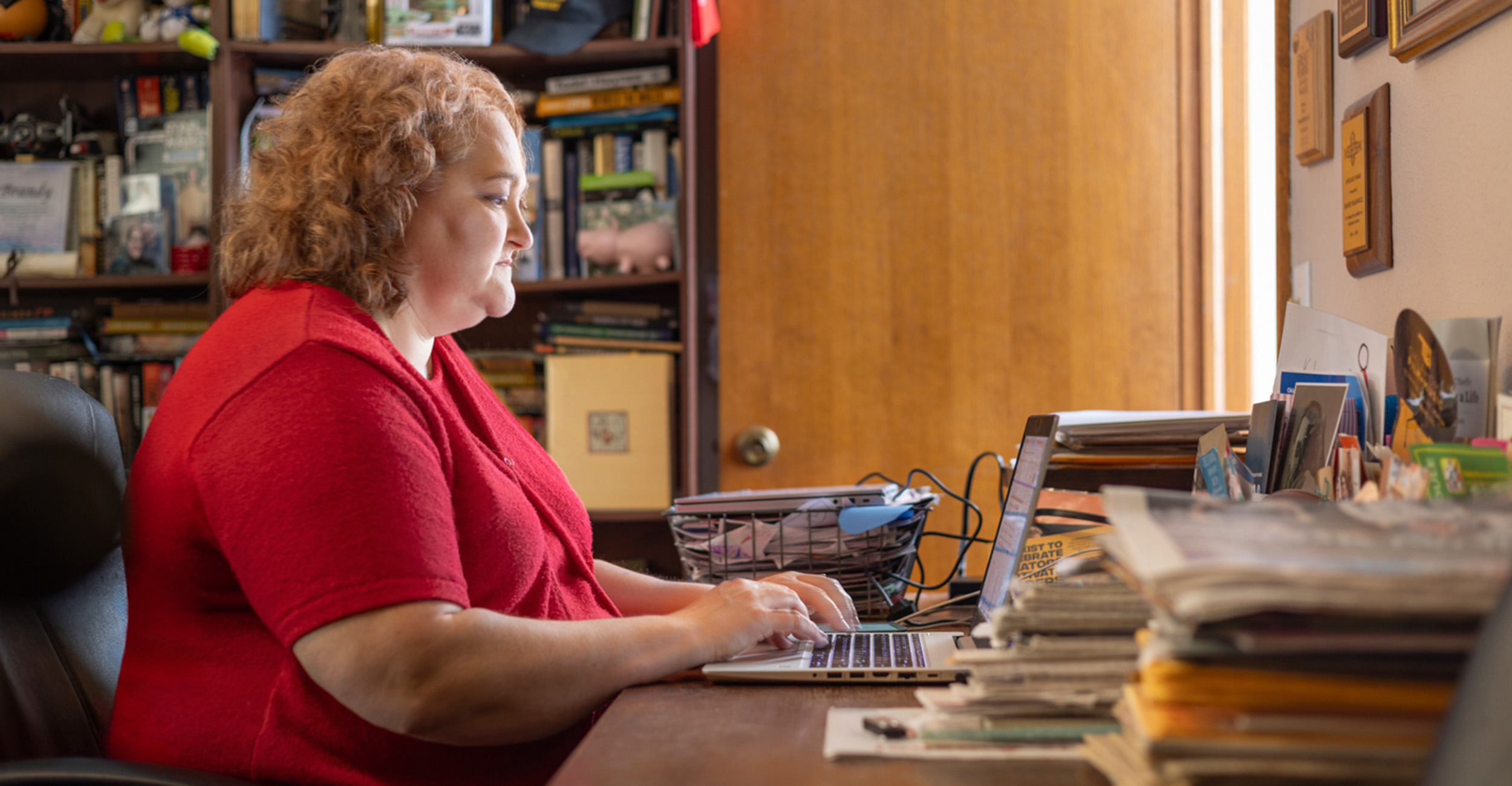
OSU alumna wins national writing award for the visual arts
Monday, October 13, 2025
Media Contact: Jordan Bishop | Editor, Department of Brand Management | 405-744-7193 | jordan.bishop@okstate.edu
Brandy McDonnell walked into church holding a neatly folded piece of paper that would someday lead to her being named at the top of her field, claiming the title as one of the best visual writers out there.
No, the paper that McDonnell had written in her best handwriting before handing it to Meridon Cable, her local newspaper publisher, was not about the arts. Instead, it was a simple report on the 4-H Club’s most recent meeting.
You see, McDonnell had just been named the club’s reporter. And write for the local newspaper was what reporters did, she said.
“I only knew one kind of reporter, the one who would write for a newspaper,” McDonnell said. “I didn't even know there was another kind of reporter when I was in seventh grade.”
That first story, which ran verbatim in “The Lindsay News,” was the start of a career for the Oklahoma State University alumna who was recently awarded the Rabkin Prize. The award is given to a select few visual arts writers annually, which, this year, included McDonnell, “The Oklahoman” features writer for over two decades.
“It's pretty stunning to get national recognition for something that you've been doing, especially here in Oklahoma, where we sort of still see ourselves as a little bit out of the way, a little bit off the beaten path, out of the mainstream,” McDonnell said. “I never really imagined that I would win a national award for something like that; I wouldn't even have known to aspire to it.”
McDonnell didn’t even know if she wanted to be a writer. Yes, she turned that 4-H Club reporter job into a gig working for the paper in her hometown of Lindsay, Oklahoma. But she was more interested in the arts, in how creators came up with inspiration, in how productions were made.
Little did she know then that she would find the perfect career to combine the two at OSU.
As a small-town, southern Oklahoma resident, McDonnell thought she would go to the University of Oklahoma. It is where all her friends went, and Norman was only 38 miles up Highway 59 from Lindsay.
After all, an older cousin was already a theatre student at OU. It seemed like a perfect fit. When she went on a college visit, though, she didn’t feel like it was a good match.
So, McDonnell’s mother mentioned going to Stillwater to see the OSU campus. There, she immediately felt a connection.
“I may have already been a senior whenever I decided I was going to go to OSU,” she said. “So, it was fairly last-minute that I decided to go to OSU, and I never regretted it, not one day.”
Although she had found her university, McDonnell had yet to find a major that suited her needs. She looked into everything, as long as it wasn’t math-related.
“I'm fine at math. I just don't care for it,” she said.
Those studies took her through sociology, psychology, theatre (where she learned the art of film criticism, a skill she would later use). Eventually, her College of Arts and Sciences advisor told McDonnell she had to pick something.
“All roads just sort of kept leading me back to journalism, because it sort of checks all of the boxes of my personality and interests, honestly,” McDonnell said. “... Once I had declared my major as a journalist, I started working for ‘The O’Colly’ and I thought, “OK, I was not wrong. This is where I belong.’ … So that was really, for me, a big turning point, starting to work for ‘The O’Colly’ and actually do the thing.”

At OSU, McDonnell became the features writer and later editor of ‘The O’Colly,” eventually graduating from the School of Media and Strategic Communications in 1999 with a bachelor’s degree in journalism.
During her time at the student-run newspaper, she worked closely with her advisor, Jack Lancaster, to hone her craft in covering the arts. One of McDonnell’s favorite professors, Dr. Joey Senat, actually thought she was on her way to being an investigative reporter. But her love for the arts won out.
“It's really important to know what you're good at. It's really important to know what you're not as good at, what you want to do, what you're not as comfortable doing,” she said. “I think it's important to know those things about yourself. Sometimes, I think journalists are a little bit more clear-eyed at looking at other people than they are themselves, but that's probably true of all people. … Because I think journalism is really hard. It's a very hard job. It's more of a calling than it is a job. Not that I would do it necessarily for free, because I can't afford to, but I think it's important to sort of know where you want to be and what specifically you want to be doing and who you're willing to do it with, because it's too hard to do it otherwise.”
McDonnell has found that some of the hard news has become intertwined with her features career from time to time, though. Especially as Oklahoma has become a popular filming location in the last decade, something unimaginable when McDonnell began working at “The Oklahoman” in 2002.
Over the past 15 years, movies like “Killers of the Flower Moon,” “August: Osage County” and “Minari” were filmed in and around Oklahoma, with the Tulsa area becoming a hotbed for TV shows like “Reservation Dogs” and “The Lowdown” — both from Oklahoma filmmaker Sterlin Harjo.
It’s a far cry from the Oklahoma that McDonnell grew up in when Hollywood could only be accessed in the wintertime with her dad.
“I grew up on a farm, and so my dad was very busy during most of the year, but there was this window in the wintertime, where he wasn't quite as busy, and that's what he liked to do, watch old movies and things like that,” McDonnell said. “And so we would watch a lot of movies, and I was always interested in what went into the creation of that.”
Now, film and TV crews are here year-round, with McDonnell getting to cover the legislative aspect of it with tax credits, along with the actual production of these projects.
It’s something new every day for her. Her features desk covers a variety of topics. At the heart of it is informing readers what their arts and entertainment options are, what makes these events special, and, with the review aspect, if they are worth seeing.
McDonnell said it’s more than just giving tour dates and showtimes. People can find those anywhere.
“It's more about trying to introduce people to what's going on locally, what's being locally created, who are the local creators and creatives that are out there,” she said. “So, that's a big core part of the job. There's a certain amount of utility to the information. I mean, it's about telling people what their options are with a very Oklahoma-specific angle.”
Some examples include her and “The Oklahoman” team’s coverage of the Tulsa Race Massacre centennial in 2021, where McDonnell found the arts actually play a critical role in the history of events and how they are perceived.
“I did have a moment right before it was announced where I was saying something along those lines, ‘It's like nobody ever gets a Pulitzer Prize for writing about an art exhibit or something like that.’ And my husband said, ‘Well, I guess you did kind of win the Pulitzer Prize of doing that.’ I thought, ‘Holy crap, I won the Pulitzer of my job.’”
Another, and a favorite of McDonnell’s, is the tale of Elmer McCurdy — an aspiring outlaw who didn’t quite have the skillset for a life of crime. He was gunned down near Pawhuska on Oct. 7, 1911, at the age of 31, with his body being claimed by a local undertaker who would use it to practice embalming.
Over the years, McCurdy’s body became mummified, later being sold to a traveling roadshow and then disappearing for decades before being discovered in a warehouse by a crew filming an episode of “The Six Million Dollar Man” in December 1976. McCurdy was eventually buried in Guthrie, Oklahoma, (alongside fellow Wild West outlaw Bill Doolin).
McDonnell’s 2022 story on McCurdy has, like the man it is about, continued to live on. A musical “Dead Outlaw” has been made about him, drawing rave reviews and earning a place on Broadway.
“I mean, there's something about that, right? This guy, who was terrible at being a criminal and died when he was in his 30s,” McDonnell said. “Now people are still talking about him over 100 years after he died. He was buried the year I was born, and people are talking about him. So I guess there's hope for all of us.”
This body of work led to the nomination and winning of the Rabkin Prize, something McDonnell never saw coming.
“There's not a lot of recognition in journalism that centers on features reporting or art reporting or something like that. I mean, you pretty much know going into this that the Pulitzer committee isn't having to do with you, like they don't care,” McDonnell said. “I did have a moment right before it was announced where I was saying something along those lines, ‘It's like nobody ever gets a Pulitzer Prize for writing about an art exhibit or something like that.’ And my husband said, ‘Well, I guess you did kind of win the Pulitzer Prize of doing that.’ I thought, ‘Holy crap, I won the Pulitzer of my job.’”
Although it isn’t always the most glamorous of jobs, McDonnell does think it is a rewarding career.
With the current journalism landscape even tougher to navigate, newspapers shuttering left and right, and misinformation filling the gap once populated by local newspapers, McDonnell notes that it is hard, but still challenges young writers to find the beat they love and cover it to the best of their ability.
“I’m a really big proponent in working a beat, being aware of what's happening in the arts community, what's happening in the film community, keeping pace to what's happening,” McDonnell said. “If you think it's news, or if you think that there's a story there that can be told in an interesting way, then it probably is.
Those messages double for students at OSU, where she and her sister, Desty, both graduated, where McDonnell met her husband, Patrick, and where their son, Gabriel, is a member of the Cowboy Marching Band.
“Every once in a while, I'll go through walking through the Oklahoma City Museum of Art, and I will remember something from one of those art history classes, just sort of like, ‘Oh, I remember this.’ It sort of comes out of my brain and out of my mouth, and I think, ‘Wow, I'm surprised I still remember that after 25 years, but I do, apparently,” McDonnell said. “So, I feel like there's a lot of what I learned in journalism and outside of journalism that really got me where I am today. … It really does play a key part in my whole success as a journalist.
